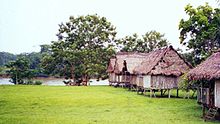Napo River
[6][7][8] Before it reaches the plains it receives a great number of small streams from impenetrable, saturated and much broken mountainous districts, where the dense and varied vegetation seems to fight for every piece of ground.From its Coca branch to the mouth of the Curaray the Napo is full of snags and shelving sandbanks and throws out numerous canoes among jungle-tangled islands, which in the wet season are flooded, giving the river an immense width.From the Coca to the Amazon it runs through a forested plain where not a hill is visible from the river - its uniformly level banks being only interrupted by swamps and lagoons.From the Amazon the Napo is navigable for river craft up to its Curaray branch, a distance of about 216 mi (348 km), and perhaps a bit further; thence, by painful canoe navigation, its upper waters may be ascended as far as Santa Rosa, the usual point of embarkation for any venturesome traveller who descends from the Quito tableland.The Coca river may be penetrated as far up as its middle course, where it is jammed between two mountain walls, in a deep canyon, along which it dashes over high falls and numerous reefs.
Amazon BasinEcuadorAmazon RiverIquitosLoreto RegionMazánBella VistaSanta ClotildeNueva RocafuertePuerto Francisco de OrellanaAmazonAtlantic OceanRiver systemAguaricoTiputiniYasuníCuraraySpanishtributaryAndeanvolcanoesAntisanaCotopaxiCoca RiverCayambe volcanoequatorColombiaTungurahua volcanowet seasonswampslagoonsconquistadorGonzalo PizarroRiver kilometerElevationDrainage basindischargeCabo PantojaNuevo RocafuerteBellavistasediment loadPayaminoLake PilchicochaFood and Agriculture Organization of the United NationsBibcode